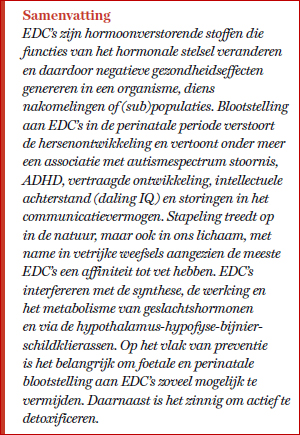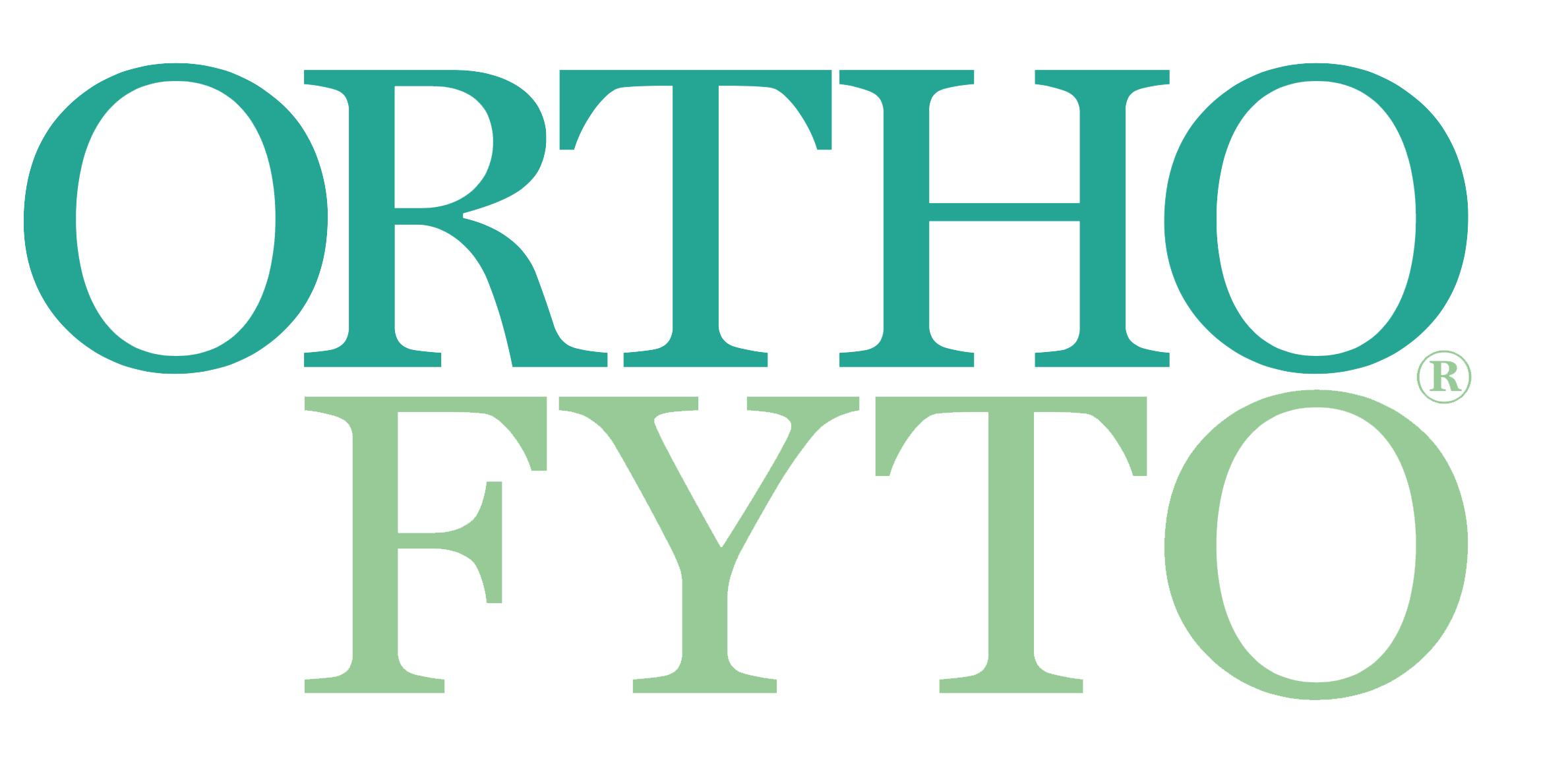Blootstelling aan hormoon verstorende stoffen
09 Apr, 2020
Door: Anna Kruyswijk-van der Heijden
 Een recente systematic review schetst een alarmerend beeld van de gevolgen voor de hersenontwikkeling door blootstelling, in de perinatale periode, aan hormoon verstorende stoffen: Endocrine Disrupting Chemicals ofwel EDC’s. De resultaten tonen een associatie met autismespectrum stoornis, ADHD, vertraagde ontwikkeling, intellectuele achterstand (daling IQ), storingen in het vermogen tot communicatie en onspecifieke neuro-ontwikkelingsstoornissen.1 De eerste publicatie over EDC’s op Pubmed dateert uit 1993.2
Een recente systematic review schetst een alarmerend beeld van de gevolgen voor de hersenontwikkeling door blootstelling, in de perinatale periode, aan hormoon verstorende stoffen: Endocrine Disrupting Chemicals ofwel EDC’s. De resultaten tonen een associatie met autismespectrum stoornis, ADHD, vertraagde ontwikkeling, intellectuele achterstand (daling IQ), storingen in het vermogen tot communicatie en onspecifieke neuro-ontwikkelingsstoornissen.1 De eerste publicatie over EDC’s op Pubmed dateert uit 1993.2
De WHO hanteert de volgende definitie van EDC’s: stoffen die een of meer functies van het hormonale stelsel veranderen en daardoor negatieve gezondheidseffecten genereren in een organisme, diens nakomelingen of (sub)populaties. Naar schatting zijn er meer dan duizend stoffen die hormoonverstorende eigenschappen hebben.3 EDC’s maken deel uit van de 80.000 nieuwe chemische stoffen die de afgelopen decennia zijn ontwikkeld. Slechts van een paar honderd is de ADI (Acceptable Daily Intake) bepaald; de maximale hoeveelheid die je levenslang binnen mag krijgen zonder dat het schadelijk is voor je gezondheid. Meestal wordt dan ook de NOAL (No Observed Effect Level) bepaald, de dosering waarbij geen waarneembare problemen optreden.
EDC’s zijn synthetische chemische stoffen, die grotendeels niet afbreekbaar zijn in de natuur, reden waarom ze ook wel POP’s genoemd worden, Persistent Organic Pollutants. Stapeling treedt op in de natuur, maar ook in ons lichaam en wel met name in vetrijke weefsels – borsten, hersenen, adipeus en visceraal vetweefsel – aangezien de meeste EDC’s een affiniteit tot vet hebben. Ze komen binnen via voedsel en water en in mindere mate via lucht en huidcontact. Het ongeboren kind en het zeer jonge kind zijn het meest kwetsbaar, waarbij het tijdvenster van blootstelling belangrijk is. De puberteit is eveneens een gevoelige periode. Maar ook daarbuiten is blootstelling aan EDC’s niet zonder risico.
www.jouwvoeding.com Lees het gehele artikel vanaf pagina 34 in OrthoFyto 2/20. Wilt u het gehele artikel als PDF bestand ontvangen? Bestel het dan hier voor € 3,50 Bronvermelding:- Rivollier F. et al. Perinatal Exposure to Environmental Endocrine Disruptors in the Emergence of Neurodevelopmental Psychiatric Diseases: A Systematic Review. Int. J. Environ. Res. Public Health 2019, 16, 1318; doi:10.3390/ijerph16081318
- Colborn T. et al. Developmental effects of endocrine-disrupting chemicals in wildlife and humans. Environ Health Perspect. 1993 Oct;101(5):378-84
- WHO 2012 Possible developmental early effects of endocrine disrupters on child health
- Lauretta R. et al. Endocrine disrupting Chemicals: effects on endocrine glands. Front Endocrinol 2019;10(178):1-7
- Darbre PD. Overview of air pollution and endocrine disorders. Int J Gen Med 2018;11:191-207
- Docea AO. et al. Six months exposure to a real life mixture of 13 chemicals' below individual NOAELs induced non monotonic sex-dependent biochemical and redox status changes in rats. Food Chem Toxicol. 2018;115:470-481
- Papalou O. et al. Endocrine Disrupting Chemicals: An Occult Mediator of Metabolic Disease. Front. Endocrinol 2019; 10(12):1-14
- Azzouz A. et al. Determination of free and conjugated forms of endocrine-disrupting chemicals in human biological fluids by GC-MS. Bioanalysis. 2016;8(11):1145-58
- Piecha R. et al. Urine levels of phthalate metabolites and bisphenol A in relation to main metabolic syndrome components: dyslipidemia, hypertension and type 2 diabetes, a pilot study. Cent Eur J Public Health 2016; 24 (4): 297–301
- Yilmaz B. et al. Endocrine disrupting chemicals: exposure, effects on human health, mechanism of action, models for testing and strategies for prevention. Rev Endocr Metab Disord 2019. doi: 10.1007/s11154-019-09521-z
- Lubrano C. et al. Obesity and Metabolic Comorbidities: Environmental Diseases? Oxid Med Cell Longevity 2013;2013:640673. doi: 10.1155/2013/640673
- Tsatsaki A. et al. Genotoxic, cytotoxic, and cytopathological effects in rats exposed for 18 months to a mixture of 13 chemicals in doses below NOAEL levels. Toxicol Lett. 2019;316:154-170.
- Walley SN, Roepke TA. Perinatal exposure to endocrine disrupting compounds and the control of feeding behavior—an overview. Horm Behav . 2018 ; 101: 22–28. doi:10.1016/j.yhbeh.2017.10.017
- Velmurugan G. et al. Gut Microbiota, Endocrine Disrupting Chemicals, and the Diabetes Epidemic. Trends in Endocrinol & Metabol. 2017;28(8):612-625
- Yuan X. et al. Gut microbiota: An underestimated and unintended recipient for pesticide-induced toxicity. Chemosphere. 2019;227:425-434
- Harley KG. et al. Association of phthalates, parabens and phenols found in personal care products with pubertal timing in girls and boys. Hum Reprod. 2019;34(1):109-117
- Smith J. Survey Reports Improved Health After Avoiding Genetically Modified Foods. Int J Human Nutr and Funct Med 2017
- Barański M. et al. Higher antioxidant and lower cadmium concentrations and lower incidence of pesticide residues in organically grown crops: a systematic literature review and meta-analyses. Br J Nutr. 2014;112(5):794-811
- Bradman A. et al. Effect of Organic Diet Intervention on Pesticide Exposures in Young Children Living in Low-Income Urban and Agricultural Communities. Env Health Persp 2015;123(10):1086-1093
- Hyland C. et al. Organic diet intervention significantly reduces urinary pesticide levels in U.S. children and adults. Environmental Research 2019;171:568-575
- Warner GR. et al. Mechanisms of action of agrochemicals acting as endocrine disrupting chemicals. Mol Cell Endocrinol. 2019 Dec 12:110680. doi: 10.1016/j.mce.2019.110680
- Li S. et al. Prenatal epigenetics diets play protective roles against environmental pollution. Clin Epigen 2019;11(82):1-31
- Kruyswijk- v.d. Heijden AM. Eenvoudig Gezond. Jouw Voeding 6e druk 2018. ISBN 9789087593858
- Kruyswijk- v.d. Heijden AM. Keto-Detox. Jouw Voeding 1e druk 2019. ISBN 9789090323152
- Saihara K. et al. Pyrroloquinoline Quinone, a Redox-Active o-Quinone, Stimulates Mitochondrial Biogenesis by Activating the SIRT1/PGC-1α Signaling Pathway. Biochemistry. 2017;56(50):6615-6625
- Genuis SJ. et al. Human excretion of bisphenol A: blood, urine, and sweat (BUS) study. J Environ Public Health 2012;2012:185731
- Sears ME. et al. Arsenic, cadmium, lead, and mercury in sweat: a systematic review. J Environ Public Health 2012;2012:184745
- Merino JJ. et al. The Long-Term Algae Extract (Chlorella and Fucus sp) and Aminosulphurate Supplementation Modulate SOD-1 Activity and Decrease Heavy Metals (Hg++, Sn) Levels in Patients with Long-Term Dental Titanium Implants and Amalgam Fillings Restorations. Antioxidants 2019, 8, 101; doi:10.3390/antiox8040101
- Bukhari SA. et al. Phylogeny and comparative modeling of phytochelatin synthase from Chlorella sp. as an efficient bioagent for detoxification of heavy metals. J Biol Regul Homeost Agents. 2018;32(5):1191-1197
- Bisanz JE. et al. Randomized Open-Label Pilot Study of the Influence of Probiotics and the Gut Microbiome on Toxic Metal Levels in Tanzanian Pregnant Women and School Children. MBio. 2014;5(5):e01580-14
